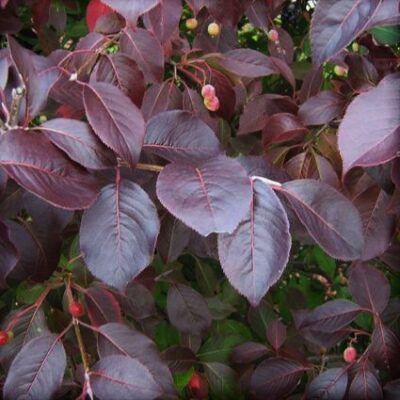Garden Plant: Forest Rouge Blackhaw Viburnum
Product Description: Forest Rouge Blackhaw Viburnum

Incredible Fall Color Forest Rouge Blackhaw Viburnum
- Outstanding Maroon Fall Color Lasts and Lasts
- Grows in Sun or Partial Shade
- Flat Topped Clusters of Creamy White Flowers Appear in Mid Spring
- Blue Black Fruit for Wildlife Called Wild Raisins
- Oval Upright Form
- Hardy Native
Fall color in the shade is hard to come by. Often plants need full sun to bring out their strongest fall color. Not so with the Forest Rouge Blackhaw Viburnum, (Viburnum prunifolium \’McKRouge’), it can develop a wonderful fall color display with only a few hours of sunlight a day.
The leathery, large leaves start out as beautiful yellow-green foliage in the spring and age to a dark, shiny green for summer. The new leaves are visually boosted by showy young stems, which emerge dark red. You’ll love the contrast!
Large clusters of creamy-white flat-topped flowers appear in mid-spring. They resemble the pretty, delicate Elderberry flowers, and butterflies adore them.
Over time, the flowers develop into handsome, bluish-black berries that hold on the plant from fall until winter. That is, if your local bird population doesn’t strip them first. These plants are wonderful natural bird feeders and help support birds in your area.
Of course, You’ve probably studied the photos of that deep, delicious fall color. It’s one of the best displays available from native plants. It starts early and ends late, too.
Some leaves start to show color in August, and they hold the deep maroon color late into the season. The exterior leaves are purplish, and the interior leaves turn very red. This shrub is highly recommended for showy fall foliage. It gives a dependable performance year after year that lasts a long time from late summer into fall.
This spectacular native plant should be strongly considered to grace your landscape all year-long. Order today and get started enjoying it this year.
How to Use Forest Rouge Blackhaw Viburnum in the Landscape
The selection of this hardy native bush will happily show off in a partially shady corner of your garden. It will perform equally well as in a sunny spot. You’ll want to be sure to site it where You’ll see it, either from the house, or along the path to a special destination spot in your landscape.
This marvelous native shrub really has it all. Deep fall color, rugged good looks, delicate spring flowers for butterflies and honeybees and built-in bird feed in autumn and winter. You’ll feel great about including Forest Rouge Blackhaw Viburnum in your landscape.
Give it plenty of room to grow into its mature size and spread. This is a plant that looks best in a naturalized setting.
The Blackhaw berries are nicknamed Wild Raisin. These deep purple fruits are high in Vitamin C and full of carbohydrates. They’ll definitely become a favorite for your local songbirds!
Include it with other Viburnum species as a very special mixed shrub border. Add Chickasaw Plum support the needs of wildlife on your property. Introduce more berries for birds from us collection of Aronia Chokeberry shrubs.
Or, pair it with a grouping of Eastern Red Cedar, or Eastern White Pine trees. Its lavish fall tones truly pop near evergreen plants. Underplant the sunny side with smaller evergreens, such as Blueberry Delight Juniper.
Commercial property owners, create foot traffic for your business with an application of earth-friendly plants, especially if you have a natural water feature like a creek running on the grounds. This tall shrub makes a dynamic mass planting, and can be used to fill wide, open ground.
Be sure to advertise your landscape design choices with on-site plant identification plaques and a full description online. After all, customers are using their dollars these days to show appreciation for thoughtful corporations. Make a big splash with Forest Rouge Blackhaw Viburnum.
Plant 4 feet apart on center to create a solid screen. You’ll measure from the center of one to the center of the next. Mulch newly installed mass plantings and keep them weeded until the plants grow to touch.
Another unique way to use these sculptural plants is as a standalone specimen. Try them in the center of a formal planting bed, outlined in sheared Boxwood hedging. This subtle play between formal edging and the freeform shape of your Blackhaw will give your landscape a very modern feel.
Pro Plant Tips for Care
Forest Rouge Blackhaw will excel in partial shade or full sun. They require at least 4 hours of sunlight to produce the best fall color.
Ensure the planting site is well-drained. This plant is adaptable to a variety of soil types, from sandy loam to clay, as long as they drain well.
You can also plant in a raised bed, or mounded heap of soil brought in to a level of 18 inches above your soil. Plant directly in that mound to improve drainage.
Give new plants a moderate amount of water on a regular basis. Once their roots are established in your soil, they are more resilient. However, if you have an extended dry period without rainfall, be sure to soak the ground all around the plant. Cover the root system with a thick layer of mulch to conserve moisture and extend the time between watering.
Prune to shape after the spring flowers. You can periodically cut 1 or 2 of the thickest, oldest stems off at the base of the plant to rejuvenate it. Have a care when doing this, as you want to ensure a balanced canopy will remain. Trim shoots in early spring as you prefer or allow them to expand your planting over time.
Don’t wait for one of these native beauties! Order your Forest Rouge Blackhaw Viburnum from the expert growers today.


